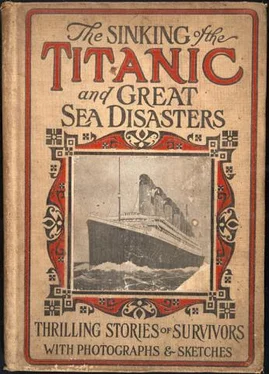Logan Marshall - Sinking of the Titanic and Great Sea Disasters
Здесь есть возможность читать онлайн «Logan Marshall - Sinking of the Titanic and Great Sea Disasters» весь текст электронной книги совершенно бесплатно (целиком полную версию без сокращений). В некоторых случаях можно слушать аудио, скачать через торрент в формате fb2 и присутствует краткое содержание. Год выпуска: 1912, Жанр: Прочая документальная литература, на английском языке. Описание произведения, (предисловие) а так же отзывы посетителей доступны на портале библиотеки ЛибКат.
- Название:Sinking of the Titanic and Great Sea Disasters
- Автор:
- Жанр:
- Год:1912
- ISBN:нет данных
- Рейтинг книги:4.5 / 5. Голосов: 2
-
Избранное:Добавить в избранное
- Отзывы:
-
Ваша оценка:
- 100
- 1
- 2
- 3
- 4
- 5
Sinking of the Titanic and Great Sea Disasters: краткое содержание, описание и аннотация
Предлагаем к чтению аннотацию, описание, краткое содержание или предисловие (зависит от того, что написал сам автор книги «Sinking of the Titanic and Great Sea Disasters»). Если вы не нашли необходимую информацию о книге — напишите в комментариях, мы постараемся отыскать её.
’s demise!
Sinking of the Titanic and Great Sea Disasters — читать онлайн бесплатно полную книгу (весь текст) целиком
Ниже представлен текст книги, разбитый по страницам. Система сохранения места последней прочитанной страницы, позволяет с удобством читать онлайн бесплатно книгу «Sinking of the Titanic and Great Sea Disasters», без необходимости каждый раз заново искать на чём Вы остановились. Поставьте закладку, и сможете в любой момент перейти на страницу, на которой закончили чтение.
Интервал:
Закладка:
Robert W. de Forest, chairman of the Red Cross Relief Committee of the Charity Organization Society, after conferring with Mayor Gaynor, said that in addition to an arrangement that all funds received by the mayor should be paid to Jacob H. Schiff, the New York treasurer of the American Red Cross, the committee had decided that it could turn over all the immediate relief work to the Women’s Relief Committee.
The Red Cross Committee announced that careful plans had been made to provide for every possible emergency.
The emergency committee received a telegram that Ernest P. Bicknell, director of the American Red Cross, was coming from Washington. The Red Cross Emergency Relief Committee was to have several representatives at the pier to look out for the passengers on the Carpathia. Mr. Persons and Dr. Devine were to be there and it was planned to have others.
The Salvation Army offered, through the mayor’s office, accommodation for thirty single men at the Industrial Home, 533 West Forty-eighth Street, and for twenty others at its hotel, 18 Chatham Square. The army’s training school at 124 West Fourteenth Street was ready to take twenty or thirty survivors. R. H. Farley, head of the White Star Line’s third class department, said that the line would give all the steerage passengers railroad tickets to their destination.
Mayor Gaynor estimated that more than 5000 persons could be accommodated in quarters offered through his orders. Most of these offers of course would have to be rejected. The mayor also said that Colonel Conley of the Sixty-ninth Regiment offered to turn out his regiment to police the pier, but it was thought that such service would be unnecessary.
Long before dark on Thursday night a few people passed the police lines and with a yellow card were allowed to go on the dock; but reports had been published that the Carpathia would not be in till midnight, and by 8 o’clock there were not more than two hundred people on the pier. In the next hour the crowd with passes trebled in number. By 9 o’clock the pier held half as many as it could comfortably contain. The early crowd did not contain many women relatives of the survivors. Few nervous people could be seen, but here and there was a woman, usually supported by two male escorts, weeping softly to herself.
On the whole it was a frantic, grief-crazed crowd. Laborers rubbed shoulders with millionaires.
The relatives of the rich had taxicabs waiting outside the docks. The relatives of the poor went there on foot in the rain, ready to take their loved ones.
A special train was awaiting Mrs. Charles M. Hays, widow of the president of the Grand Trunk Railroad. A private car also waited Mrs. George D. Widener.
Among the first to arrive at the pier was a committee from the Stock Exchange, headed by R. H. Thomas, and composed of Charles Knoblauch, B. M. W. Baruch, Charles Holzderber and J. Carlisle. Mr. Thomas carried a long black box which contained $5000 in small bills, which was to be handed out to the needy steerage survivors of the Titanic as they disembarked.
With the early arrivals at the pier were the relatives of Frederick White, who was not reported among the survivors, though Mrs. White was; Harry Mock, who came to look for a brother and sister; and Vincent Astor, who arrived in a limousine with William A. Dobbyn, Colonel Astor’s secretary, and two doctors. The limousine was kept waiting outside to take Mrs. Astor to the Astor home on Fifth Avenue.
The Waldorf-Astoria had sent over eight limousine car to convey to the hotel these survivors:
Mrs. Mark Fortune and three daughters, Mrs. Lucien P. Smith, Mrs. J. Stewart White, Mrs. Thornton Davidson, Mrs. George C. Douglass, Mrs. George D. Widener and maid, Mrs. George Wick, Miss Bonnell, Miss E. Ryerson, Mrs. Susan P. Ryerson, Mrs. Arthur Ryerson, Miss Mary Wick, the Misses Howell, Mrs. John P. Snyder and Mr. and Mrs. D. H. Bishop.
At one time there were thirty-five ambulances drawn up; outside the Cunard pier. Every hospital in Manhattan, Brooklyn and the Bronx was represented. Several of the ambulances came from as far north as the Lebanon Hospital, in the Bronx, and the Brooklyn Hospital, in Brooklyn.
Accompanying them were seventy internes and surgeons from the staffs of the hospitals, and more than 125 male and female nurses.
St. Vincent’s sent the greatest number of ambulances, at one time, eight of them from this hospital being in line at the pier.
Miss Eva Booth, direct head of the Salvation Army, was at the pier, accompanied by Miss Elizabeth Nye and a corps of her officers, ready to aid as much as possible. The Sheltering Society and various other similar organizations also were represented, all ready to take care of those who needed them.
An officer of the Sixty-ninth Regiment, N. G. N. Y., offered the White Star Line officials, the use of the regiment’s armory for any of the survivors.
Mrs. Thomas Hughes, Mrs. August Belmont and Mgrs. Lavelle and McMahon, of St. Patrick’s Cathedral, together with a score of black-robed Sisters of Charity, representing the Association of Catholic Churches, were on the pier long before the Carpathia was made fast, and worked industriously in aiding the injured and ill.
The Rev. Dr. William Carter, pastor of the Madison Avenue Reformed Church, was one of those at the pier with a private ambulance awaiting Miss Sylvia Caldwell, one of the survivors, who is known in church circles as a mission worker in foreign fields
The Pennsylvania Railroad sent representatives to the pier, who said that the railroad had a special train of nine cars in which it would carry free any passenger who wanted to go immediately to Philadelphia or points west. The Pennsylvania also had eight taxicabs at the pier for conveyance of the rescued to the Pennsylvania Station, in Thirty-third Street.
Among those who later arrived at the pier before the Carpathia docked were P. A. B. Widener, of Philadelphia, two women relatives of J. B. Thayer, William Harris, Jr., the theatrical man, who was accompanied by Dr. Dinkelspiel, and Henry Arthur Jones, the playwright.
Commander Booth, of the Salvation Army, was there especially to meet Mrs. Elizabeth Nye and Mrs. Rogers Abbott, both Titanic survivors. Mrs. Abbott’s two sons were supposed to be among the lost. Miss Booth had received a cablegram from London saying that other Salvation Army people were on the Titanic. She was eager to get news of them.
Also on the pier was Major Blanton, U. S. A., stationed at Washington, who was waiting for tidings of Major Butt, supposedly at the instance of President Taft.
Senator William A. Clark and Mrs. Clark were also in the company. Dr. John R. MacKenty was waiting for Mr. and Mrs. Henry S. Harper. Ferdinand W. Roebling and Carl G. Roebling, cousins of Washington A. Roebling, Jr., whose name is among the list of dead, went to the pier to see what they could learn of his fate.
J. P. Morgan, Jr., arrived at the pier about half an hour before the Carpathia docked. He said he had many friends on the Titanic and was eagerly awaiting news of all of them.
Fire Commissioner Johnson was there with John Peel, of Atlanta, Gal, a brother of Mrs. Jacques Futrelle. Mrs. Futrelle has a son twelve years old in Atlanta, and a daughter Virginia, who has been in school in the North and is at present with friends in this city, ignorant of her father’s death.
There was one man in that sad waiting company who startled those near him about 9 o’clock by dancing across the pier and back. He seemed to be laughing, but when he was stopped it was found that he was sobbing. He said that he had a relative on the Titanic and had lost control of his nerves.
Читать дальшеИнтервал:
Закладка:
Похожие книги на «Sinking of the Titanic and Great Sea Disasters»
Представляем Вашему вниманию похожие книги на «Sinking of the Titanic and Great Sea Disasters» списком для выбора. Мы отобрали схожую по названию и смыслу литературу в надежде предоставить читателям больше вариантов отыскать новые, интересные, ещё непрочитанные произведения.
Обсуждение, отзывы о книге «Sinking of the Titanic and Great Sea Disasters» и просто собственные мнения читателей. Оставьте ваши комментарии, напишите, что Вы думаете о произведении, его смысле или главных героях. Укажите что конкретно понравилось, а что нет, и почему Вы так считаете.












